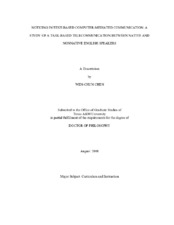| dc.contributor.advisor | Eslami, Zoheh R. | |
| dc.creator | Chen, Wen-Chun | |
| dc.date.accessioned | 2010-01-15T00:11:30Z | |
| dc.date.accessioned | 2010-01-16T01:07:14Z | |
| dc.date.available | 2010-01-15T00:11:30Z | |
| dc.date.available | 2010-01-16T01:07:14Z | |
| dc.date.created | 2008-08 | |
| dc.date.issued | 2009-05-15 | |
| dc.identifier.uri | https://hdl.handle.net/1969.1/ETD-TAMU-2938 | |
| dc.description.abstract | This dissertation investigated the occurrence and the effect of incidental
noticing in a text-based Computer-Mediated Communication (CMC) environment on
enhancing second language learning. Learning proficiency was also examined as a
possible intervening variable. This was a quasi-experimental study of sixteen nonnative
English speakers from a four-year college in Taiwan, collaborating with sixteen native
speaking peers in Texas, via chat agents in order to complete two communicative
learning tasks over a two-month period of time.
Two posttests were customized for each Nonnative English Speaker (NNES) in
order to assess his/her second language learning outcomes. In addition, Language-
Related Episode’s (LRE’s) characteristics were expected to serve as powerful
predictors of NNES’ correct language learning outcomes. In order to unveil the
possible impact of the learner’s language proficiency level and its effect on noticing,
eight low- intermediate and eight high- intermediate NNESs were included in the
study. The findings revealed that CMC context and native and nonnative English speaking task-based peer interactions promoted learner’s noticing and affected the
learning performance of NNESs of different levels. The posttest performance showed
that incidental noticing facilitated learner’s linguistic knowledge intake and memory
retention. Text-based CMC created a visual and collaborative context which allowed
NES peers to offer NNESs of different levels personalized feedback.
Among LRE’s characteristics, successful uptake, as a powerful predictor,
constantly entered all the models generated by logistic regression analysis, which
underpinned the importance of quality uptake during the two-way communication for
second language learning. In addition, directness (explicit feedback) and response
(elicitation) also appeared in regression models of the subsets of LRE data, which
indicated the particular type of feedback needed by learners, especially lower
proficiency level ones. In addition, NESs’ involvement also facilitated NNESs’
noticing; NES peers applied elicitation techniques to redirect learner’s attention to the
problematic utterances and initiated meaning negotiation. The findings reveal that
incidental noticing is beneficial to learning, especially when learners are provided with
explicit feedback and incorporate the targeted linguistic items into their language
production. | en |
| dc.format.medium | electronic | en |
| dc.format.mimetype | application/pdf | |
| dc.language.iso | en_US | |
| dc.subject | Noticing | en |
| dc.subject | CMC | en |
| dc.subject | Telecommunication | en |
| dc.subject | Task-based language learning | en |
| dc.title | Noticing in text-based computer-mediated communication: a study of a task-based telecommunication between native and nonnative English speakers | en |
| dc.type | Book | en |
| dc.type | Thesis | en |
| thesis.degree.department | Teaching, Learning, and Culture | en |
| thesis.degree.discipline | Curriculum and Instruction | en |
| thesis.degree.grantor | Texas A&M University | en |
| thesis.degree.name | Doctor of Philosophy | en |
| thesis.degree.level | Doctoral | en |
| dc.contributor.committeeMember | Larke, Patricia | |
| dc.contributor.committeeMember | McIntosh, Alex W. | |
| dc.contributor.committeeMember | Viruru, Radhika | |
| dc.type.genre | Electronic Dissertation | en |
| dc.type.material | text | en |
| dc.format.digitalOrigin | born digital | en |


